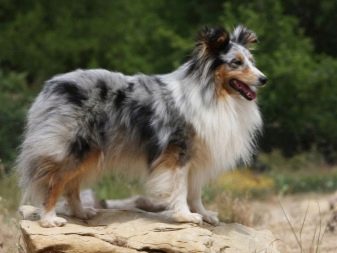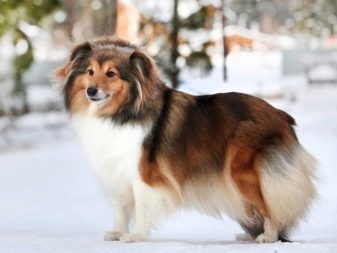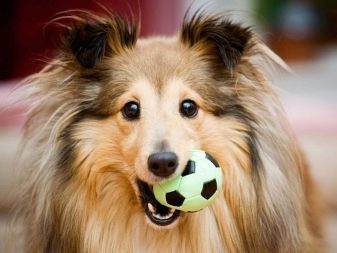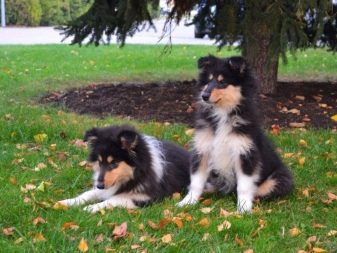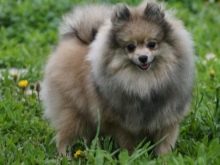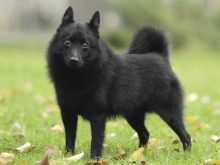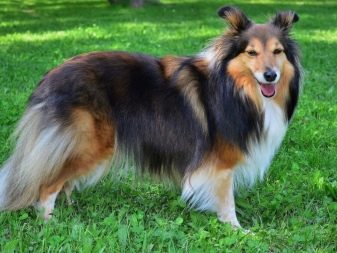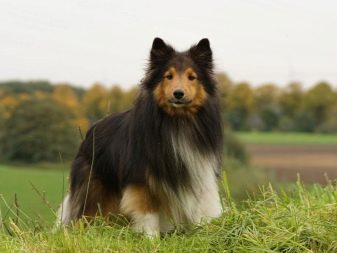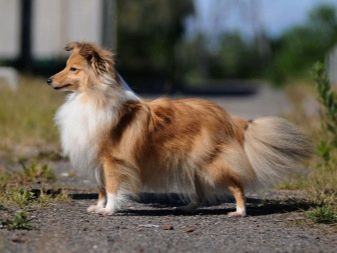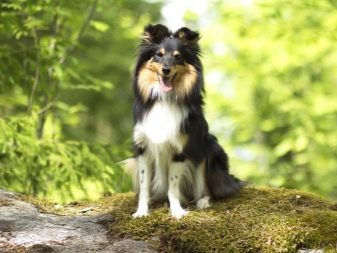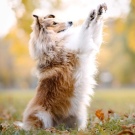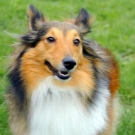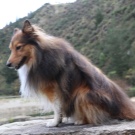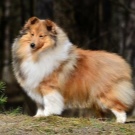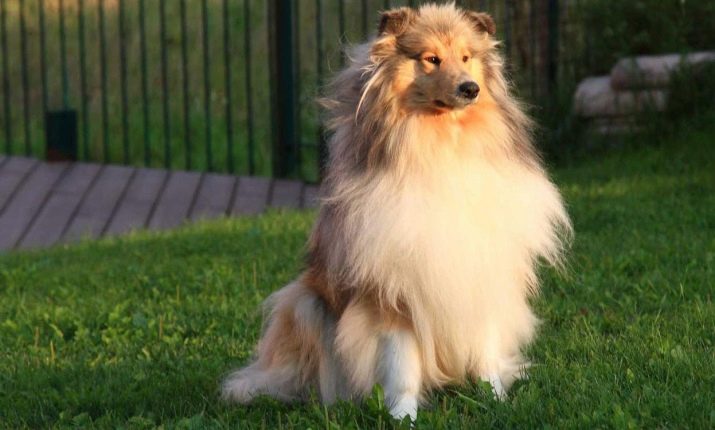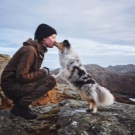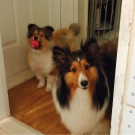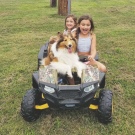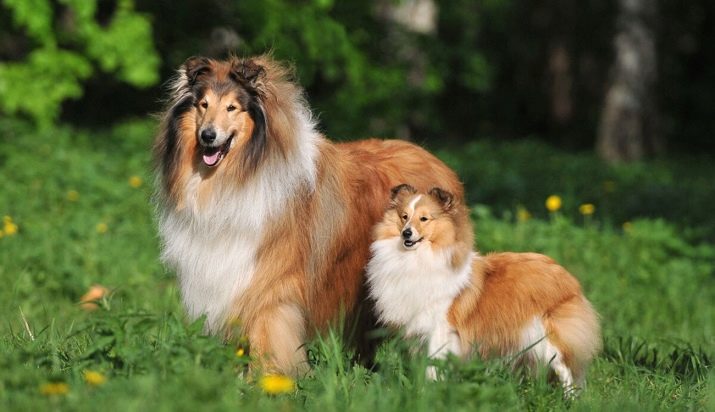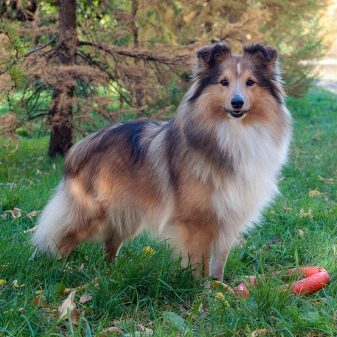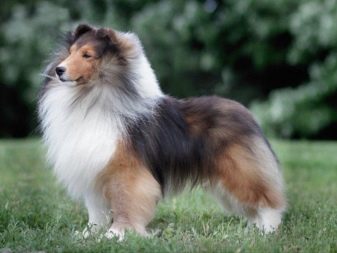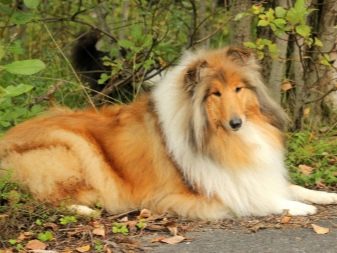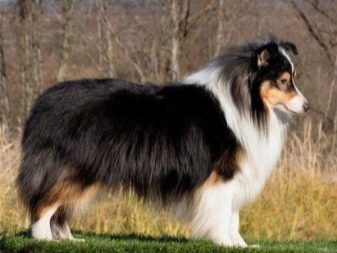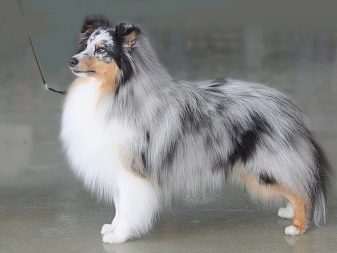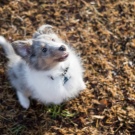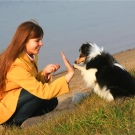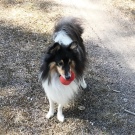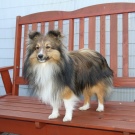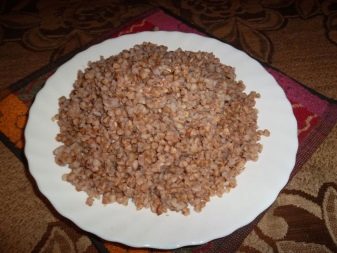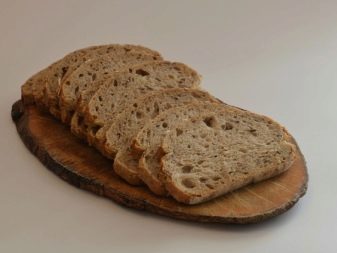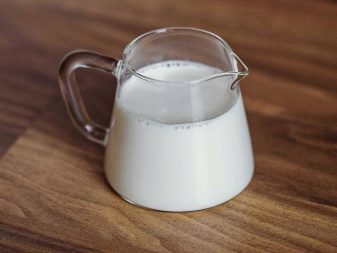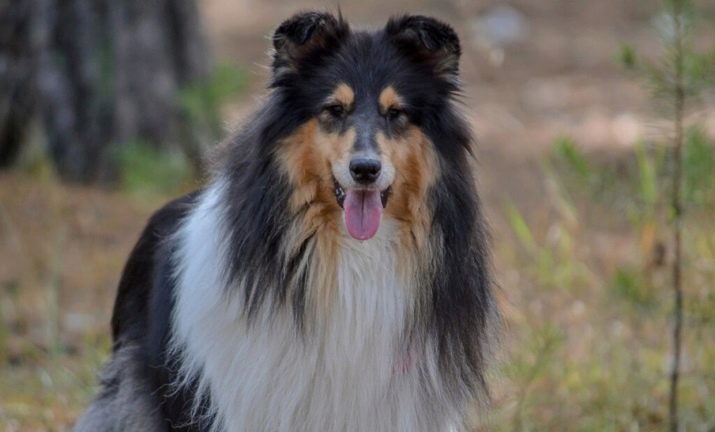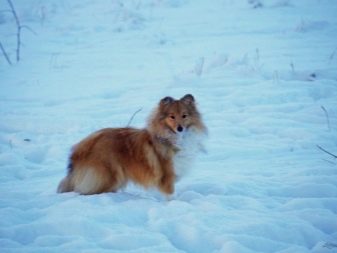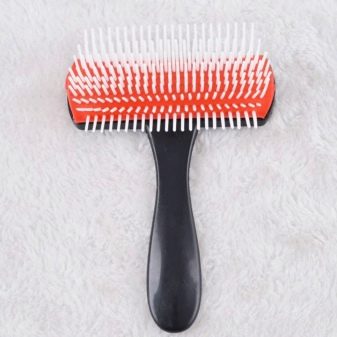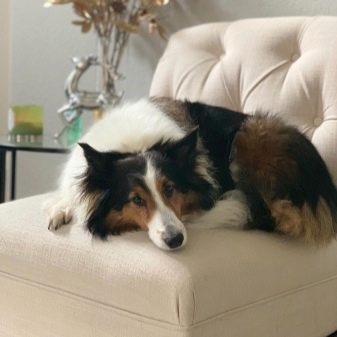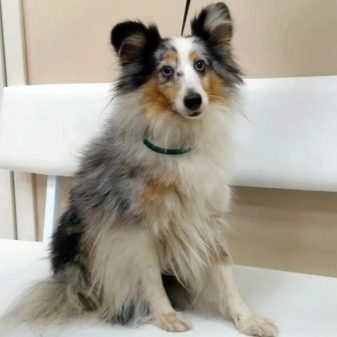Sheltie: description of dogs, color variations and features of the content
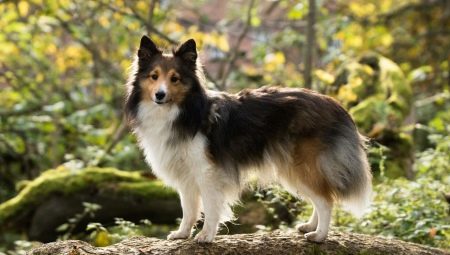
Sheltie or Shetland Sheepdog is a miniature breed of dog that is popular in England and Scotland.. Its representatives differ from their relatives by their small stature, bright and many-sided colors, and also by an incredibly active and cheerful character, which together makes the dog ideal for keeping at home.
History of origin
It is difficult to imagine, but the homeland of these extraordinary dogs, which can sometimes be found on Russian streets, is the distant Scotland. It was on the Shetland Islands a few hundred years ago, the distant ancestors of these dogs got on the ships of immigrants from the mainland. These animals were used to help shepherds, guarding and walking animals. Fertile Scottish vegetation and spacious mountain valleys have become an ideal pasture for breeding small ruminants: sheep and goats.
In the course of time, the brought individuals of dogs began to freely interbreed with local breeds.
For example, with the spitz, from which these dogs received a soft and fluffy coat, as well as a variety in colors. Over time, these sheepdogs were already intentionally crossed with representatives of other breeds in order to inherit certain external or physical qualities. According to some data: the following dog breeds participated in the formation of the Sheltie breed: Border Collie, King Charles Spaniel, Schipperke, Icelandic and Greenlandic shepherd dogs.
Initially, the ancestors of the sheltie were used exclusively in herding activities - small size allowed these dogs to freely and quickly manage with the average flocks of sheep. Shelties not only watched the beaten-off sheep, but also helped to drive the entire flock at the end of the working day from the place of grazing to the paddock, loudly informed the shepherds about the arrival of the flock.
Shelties were the perfect shepherd dog for the Scottish lands - they had a light but strong body and strong legs that allowed them to move quickly even in the most difficult areas. In addition, the long hair of these dogs allowed them to successfully endure the wet Scottish climate and significant temperature drops.
The turning point in the formation of this sheepdog breed was the beginning of the 19th century, when larger and stronger sheep breeds were bred using breeding. New breeds found a real sensation among British farmers: these individuals were more enduring, large and healthy. However, this extremely negatively affected the distribution of Shetland Sheepdog dogs.
The fact is that new individuals were more capricious and stronger than previous breeds, and therefore many sheep simply refused to obey and obey the small shelties. This led to the almost complete disappearance of the sheltie in Scotland. Soon, instead of these dogs, herds began to be protected by stronger and larger dogs - specially bred sheepdogs-herders.
It would seem that the emergence of a new strong herding breed was decisive for the development of Sheltie dogs, but this breed was not allowed to disappear.
Active restoration and development of Shetland Sheepdogs took exactly British breeders. The first club of this breed was founded in 1908 by the British breeder James Logga in the capital of the Shetland Islands Lerwick. Loggs not only opened the breed club Sheltie, but also sought to standardize this breed.
According to the original idea, these dogs were supposed to bear the name "Scottish Collies", but this name was subjected to negative criticism from the owners of purebred Collies. In the future, these dogs were given a different name. - Shetland Sheepdogswhich is used to this day.
By the beginning of the 20th century, the first Shelties were brought to North America, where they were widely spread among American dog handlers and breeders of decorative breeds of dogs. Unfortunately, the identity and official status came to these dogs only after the Second World War (1948). Prior to this, no American or British cynological association dared to give these dogs official status due to the too large external similarity of these dogs with a collie breed. Despite later recognition, the standard of these dogs was finally formed by 1914.
On the territory of Russia, these dogs appeared only in the 90s of the XX century. Despite the unusual exterior and attractive external data, the sheltie did not receive much popularity, as did the collie.
Description
It is easy for an inexperienced breeder to easily confuse Shelties and Scottish Collies - these dogs are almost identical at first glance: both breeds have the same long hair, pointed muzzle and small erect ears. Such a similarity of breeds has developed due to numerous breeding experiments to unify the breed qualities of sheltie. In the course of these experiments, individuals of many other dog breeds were used, but the basis for the creation of the breed was the genetic material of Spitz and Scottish Collies.
In contrast to tall and stately Collie, Shelties do not have such impressive size.
This characteristic is determined by the influence of Spitz genes as well as by the conditions of keeping the first representatives of this breed.
As mentioned above, the first standard of this breed was formed in 1914, after which it was not subjected to significant changes.
- Average weight. These dogs are classified as miniature dog breeds - as a rule, they weigh at least 5 and not more than 10 kilograms. Occasionally there are Sheltie individuals with minor deviations from the norm, but this is not considered a severe violation of the standard.
- Medium height. Not surprisingly, some have identified this breed of dog as a “mini-collie.” If any variety of collie can reach a height of 70 centimeters at the withers, then the optimum height for dwarf shelties will be 35-37 centimeters (adult females and males, respectively). Regarding growth, deviations of no more than 2.5 centimeters from the standard are allowed.
- Head and muzzle. Small elongated type, wedge-shaped. The muzzle is strongly narrowed to the nose. The skull is flat, there is no pronounced mound on the back of the head. Stop expressed slightly. Well visible flat cheekbones at the muzzle.
- Nose. The lobe is small but well developed with large nostrils. The color is exclusively black.
- Teeth and oral cavity. Jaws slender and elastic, well developed. Scissor bite. A special advantage in the exterior is considered to be an equal dentition of 42 teeth.
- Ears. Not particularly large, placed at a small distance from each other. In a quiet state, they are retracted, in a state of excitement they stand upright, their auricles look forward.
- Eyes. The eyes of the sheltie are small, oval, set slightly obliquely. The eyelids fit snugly to the eyeball, black. In breeds with a dark color, the iris is brown in color, in light individuals (for example, marble color) the presence of a blue color with chocolate splashes is possible.
- Neck. Not particularly long, but strong, covered with a layer of developed muscles. Slight bending is almost imperceptible under a thick layer of wool.
- Body. The back is straight, there is a beautiful bend in the lumbar region, the croup is strongly pronounced, rounded. The chest is deep, but not particularly wide.
- Limbs and paws. The front limbs are flat, set in parallel, the shoulders are laid back.The hind limbs also stand erect, the hips and knees are well defined thanks to the developed muscles. The hock joint is low enough to provide greater primary speed. The paws of a sheltie are medium in size, gathered into an oval lump. Fingers should fit snugly together.
- Movements. These dogs move quickly, but easily, gracefully and smoothly. Each step - as if sliding on the ice.
- Tail. The medium-sized tail is covered with a thick layer of wool, also of medium length. Set low, in a relaxed position, lowered, the tip reaches the level of the hock. According to the structure, the tail of the sheltie is straight, without a twisted tip. In the excited state, slightly raised, but does not rise above the level of the back. The tips of the tail in colored sheltie is usually light or white.
- Wool. There are two levels: long and coarse guard hair, retaining moisture and cold; thick, dense and soft undercoat. When stroking wool slightly springy. Chest, occipital part and neck are covered with longer hair, forming a kind of “lion's mane”, hiding the ribs and elbows.
On the outer side of the paws at the elbow joints, the presence of longer hair is also noticeable.
Character
Among all modern breeders, Shelties are considered to be an exceptionally friendly, convivial and active breed. It is necessary to consider the key features of the behavior of these dogs in different conditions of detention.
- Independence. Despite their unlimited devotion towards their owner and their family members, these dogs are also extremely independent. This is not the kind of dog that will follow you every minute on its heels and wait for any encouragement or initiative from the owner. They will not begin to cringe for the sake of delicacy, and it is impossible to rehabilitate adult shelties. Shelties will not bother their family members if they see that they are not in the mood for this now, but will gladly join in with any hints of games and adventures.
- Attitude to the owner. Some attribute these dogs to family breeds, which is not entirely correct. Truly shelties will be faithful and committed only to their master, only his commands will always be unquestioningly executed and obeyed. With the owner, these dogs feel a relationship - they always know perfectly well what he wants. They will be ready to console him in a difficult moment and have fun in the moments of his joy. Some breeders say that these dogs are prone to copying the qualities and behavior of their owner - that is why constant contact and proper training plan are so important in raising these pets. Such loyalty should be treated very carefully. If you once tamed the sheltie, then the other owner she will not be able to find.
- Attitude towards strangers. In relation to strangers, these dogs are extremely restrained. If the owner communicates with a stranger on a positive note, which positively relates to the dog itself, the sheltie individual may well give itself to stroke or scratch behind the ear. As for the rest of the action - the trust of these dogs must be earned. If the shelties notice obvious aggression on the part of the stranger, these dogs will first show warning teeth and will whimper. If the warning does not work, they may well rush to the offender to protect their master. If the sheltie is quietly resting somewhere in the corner or dormant, the approach of any stranger will be regarded for this dog as a threat to her personal space.
A full-fledged protector from this dog is unlikely to ever work out - all because of the small size of these dogs, which often affects their courage in front of a larger opponent.
- Attitude to other pets. Shelties are incredibly sociable dogs that try to find an interlocutor in every member of their family. If it is another pet, for example, a cat or another dog, the sheltie will make all attempts to express a desire to be friends.These dogs are absolutely non-aggressive and non-jealous, and therefore, due to their perseverance, they can make friends with even the most stubborn pets.
- Attitude to children. Non-aggressive, active and social shelties feel great with small family members. Shelties are seen in companions for active games, entertainment and adventure. They are not vindictive and do not remember the harassment of babies, love to protect their sleep, and often even become real pillows for their young family members.
- Vocal qualities. A feature of these dogs is the versatility of their language. They are able to whine, squeal, grumble and even purr in a state of blissful peace. Given these data, the shelties resemble domestic chanterelles, who adore affection and manifestations of attention to their person. The experienced owner of the sheltie eventually learns to recognize the desires of the dog by the tone of the sounds the dog makes. In childhood, excessive "volatility" of these dogs can bring a lot of inconvenience - it is advised to wean the appearance of a dog in the house from excessive manifestations of feelings.
- Intelligence. All individuals, whether males or bitches, equally intelligent and capable of training dogs. Sheltie is considered one of the most easily trained breeds - they have an incredibly fast response and are able to easily recognize all the commands of the host. To make sure that the dog is listening to you, it is enough to make sure that it closely follows your movements and eyes. Shelties are poorly regarded as manifestations of any aggression - moral or physical, and therefore they need to be extremely careful and tactful in training.
- Loneliness. Despite the excellent guard qualities, these dogs are not able to sit for days on end to guard someone’s property. They require constant communication and do not tolerate when the owner does not even have half an hour of time every day. That is why it is not recommended to choose these dogs for people with a tight daily schedule.
If the sheltie is alone for a long time, her behavior becomes incredibly destructive: bitten shoes, gnawed furniture and carpets are just flowers for what these dogs are capable of.
Comparison with collie
Many even experienced breeders sometimes confuse representatives of the sheltie and collie breeds. Indeed, there are breeds of dogs that have two or more varieties depending on the size and height of the dogs: for example, dachshund and mini-dachshund. However, in this case, it will be about even if similar, but independent breeds of dogs.
Consider what is common and what is the difference between the external and internal qualities of these two breeds.
Origin
One of the main differences of these dogs is the birthplace of the breed. If the shelties appeared and were bred exclusively on the Shetland Islands, then the home of the collie was the regions of Northern England and Scotland. Both breeds of dogs were originally shepherd dogs, but spitz-dogs, papillons, king-charles spaniels, shipperki, Icelandic and Greenland shepherd dogs were used to breed the sheltie, and the genetic material of the Scottish and Irish setters and greyhounds were used to develop collies.
Such external similarity of these dogs is due to the fact that during the experiments on the sheltie, the genetic material of the Collies was also used. However, the presence of genes from other dogs had its effect, due to which these breeds were still not completely identical, both externally and in temperament.
External differences
Different dogs and externally.
- Dimensions. If you adhere to the standard, the maximum height for sheltie should not be more than 39 centimeters at the withers (and not less than 33), while for a collie these values can reach from 51 to 70 centimeters, depending on the variety.
- Colors. In the standard of breed collie, only three official colors are allowed, the sheltie of these colors has more - 4.
- Head shape. Collie dogs are characterized by a narrow and long head, in the case of sheltie, it is much shorter and wider. In addition, the Sheltie's feet are much better pronounced.
- Ears. Sheltie's ears are much wider and stand very close to each other, unlike collies.
Temperament
Both dog breeds are extremely sociable and friendly, but many owners point out that the sheltie is much more active than the collie. Sheltie is more suitable for active owners who prefer long and interesting walks with games and fun. Collies are more calm, reasonable and self-sufficient. It is believed that they are more suitable for adults and elderly people as excellent companions.
The ratio of these breeds to the host also differs.
For example, shelties will almost always follow their owner and will try to attract attention with all their might. In addition, the sheltie just can not stand for a long time to be alone. As for the collie, these dogs will think a hundred more times before following you. They do not like to waste their energy and it is better to rest easy in the corner than they bother you.
Types of color
The ICF standard allows 4 official colors for Sheltie dogs.
- Black and black and white colors. Quite a common type of color in Scotland. This option also allows a small amount of brown markings on the face and limbs. Feature of color: black head, black body, mane on the chest is white, as well as limbs at the level of the metacarpus and below.
- Sable. One of the most beloved colors among breeders, is distinguished by a bright mane on the chest and a body, on which a whole palette of colors can be located in different order, from bright red to golden shades. The main difference in color is the complete absence of gray and faded zones.
- Tricolor. In this case, the coat on the dog's chest is white, and brown and red hues are arranged all over the body.
- Marble or Blue Merle. In this case, there is a light or bluish hair with dark blurred spots on the entire body of the dog, including the muzzle and abdomen. The chest is usually white.
Upbringing
Due to the high intelligence and trust of the sheltie to their owner, the education of these dogs is quick and painless. Both the owner and the dog enjoy mental and physical training - these pets love to exactly execute commands and seek favor with their owner.
In order for the sheltie training to take place as painlessly as possible, a number of points should be taken into account.
- Be patient. Remember that each trick requires a lot of repetition for good memorization and reproduction, do not demand from the dog momentary obedience. Express dissatisfaction with your voice, but do not allow situations of open aggression with beatings or insults.
- External stimuli. The main task in the education of these dogs is to achieve a calm reaction to extraneous sounds and actions that distract them greatly. This includes noise, exposure to other family members or other pets. First, the training should be held in the most quiet place so that the pet can concentrate. After six months of training, it is worth gradually transferring to the street so that your dog does not have problems with socialization.
- Promotion methods. If the pet correctly fulfills your instructions, do not forget about the banal encouragement and praise. The usual, but gentle “Well done!” Is sometimes enough to motivate the dog for the entire workout.
- Activity. Shelties are very active, restless, and playful - it can be difficult to concentrate on doing a single action.
Try to ignore the attempts of the dog to start the game or tomfoolery - so the pet will quickly understand that he will not get any delicacy for such behavior.
Nutrition
An important element in the content of any dog is a regular healthy diet with vitamins and minerals.The basis of the diet of Sheltie dogs should be foods with a high content of animal protein. The rest of the menu is occupied by plant foods, supplements and treats.
- The main dish. First of all, it is raw meat with a small amount of fat - veal, beef, lamb, chicken, turkey, rabbit meat. In addition to meat, offal in the form of spleens, liver and hearts can be used. An excellent substitute for meat will also be sea boiled fish (always with a small amount of bones). Before the pet reaches 2 months of age, meat should be served in a grated form. Remember that meat products should take at least 50% of the daily diet of the dog.
- Herbal Supplements. The following cereals can be used as nourishing plant foods: barley, rice, buckwheat, oatmeal. To make porridge tastier for a dog, it is recommended to boil them in broth with offal or meat. You can also add parsley, dill, lettuce to chopped cereals (dandelion leaves or young nettle can be used as a substitute for salt). At least once every 2-3 days shelties should be given quail or chicken yolks (raw), whites - only boiled.
- Treats. A good addition to the main dish can serve vegetable puree, berries (raspberries, strawberries), but you should not overdo it with delicacies. Vegetables must be fresh and juicy. Before using any fruit or vegetable, you should consult a veterinarian to avoid the possibility of allergies. Dried fruits can be used as a substitute for fresh fruits - sheltie dogs simply adore them.
- Ready feed. Of course, for feeding these dogs, you can use both natural food and ready-made industrial feed. In this case, experts recommend choosing exactly premium food and higher (for small dogs).
The advantage of such compounds is that they are stored for a long time and immediately contain all the necessary vitamins.
Prohibited Products
Shelties have a healthy stomach that allows them to digest almost all types of food. Only products that are equally harmful to all dogs remain harmful here:
- any kind of pastry sweets;
- tubular bones (impede digestion, get stuck in the throats);
- any bakery products or any other wheat flour products (for example, pasta);
- potatoes, legumes and fruits with high levels of acidity and fat;
- human food (spicy, smoked, salty, pickled, spicy foods);
- any dairy products, only fermented milk (cottage cheese, cheese, whey) are allowed.
Care
Shelties were originally used precisely as a shepherd breed of dogs, possessing rather long hair and strong immunity for survival in the harsh conditions of rainy Scotland. Thanks to their strong immunity, these dogs have become immune to most common diseases. That is why The main part of caring for these pets comes down to regular walks and care for their beautiful and fluffy fur.
Walking
As already mentioned, these dogs do not tolerate a long time in one place. They need fresh air, regular walks and exercise. Shelties just love to chase a frisbee or a ball through the spacious fields, often looking for insects or small animals in the grass. In this case, the shelties are trying to draw into their entertainment and games of the owner, without which their walk will be simply impossible. That is why these dogs can not be kept on the street or in the aviary. The ideal option would be a two-time walking with a total time of 2-3 hoursFor dogs, this indicator is slightly higher.
The frequency and duration of walks may vary depending on the season or age of the dog. So, if we are talking about a still young Sheltie or puppies, then they need to be walked at least 2-3 times a day, no longer than half an hour.In winter, the duration of walks is reduced - in young individuals, immunity has not yet been fully formed in order to fight serious diseases. In addition, ice tracks are characteristic of winter, from which the limbs of a young dog may form incorrectly.
Some breeders are advised to bring sheltie puppies up to 3 months exclusively on their hands.
Wool
The main problem in the care of these dogs is precisely their thick and long hair, the presence of which for many future breeders is the reason for abandoning the dog. Many believe that such a coat is a guarantee that the apartment will always have dirt and a huge amount of wool at every step. Experienced breeders claim that This problem occurs only in lazy owners, who are dishonest about combing and combing these dogs.
To protect yourself and your apartment during a shelter sheltie, you need to thoroughly comb your pet with a thick brush or a comb in the form of a glove at least twice a week. In addition to removing the dead guard hair, these devices will provide the dog's skin with a pleasant and therapeutic massage. Combing is carried out in two stages - the top coat is treated first and then the top layer of the undercoat.
The washing up
Despite such a thick and long hair, shelties do not need regular and thorough bathing. A thorough washing of wool with shampoo and lotions should be carried out no more than 1 time in 2 months. Do not be afraid to walk with these dogs in the rain - this breed has no characteristic dog smell.
Hygiene
At least once a week you should clean the ears, wash the eyes and clean the teeth. Do not forget to adjust the length of the claws. Do not neglect the usual routine examinations to determine the condition of any part of the body of the dog.
Health
Do not neglect monitoring your pet's health - watch for activity, appetite, mood, and excrement. Before you send sheltie for the first street walk, be sure to contact your veterinarian for the necessary vaccinations.
Popular nicknames
It is impossible to say that their owners select certain specific nicknames, characteristic only of shelties, for this breed of dogs. Most often, these are completely different names designed to beat a certain quality of a pet: beauty, color, activity, or thoroughbred.
Less commonly, these are non-standard names that express: the personal interests of the owner, a certain historical figure, a natural phenomenon, or even a wild animal.
Popular names for sheltie boys: Agate, Wolf, Gray, Jacques, Lure, Marcel, Marble, Nero, Oscar, Rudolph, Fred, Charlie, Yasher.
Sheltie girls are often called: Ira, Betty, Hera, Zara, Ilda, Krista, Linda, Mira, Polly, Setti, Ola, Holly, Shetty, Helene.
The most interesting about the Sheltie breed in the next video.
